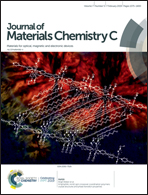Yb3+/Ln3+/Mn4+ (Ln = Er, Ho, and Tm) doped Na3ZrF7 phosphors: oil–water interface cation exchange synthesis, dual-modal luminescence and anti-counterfeiting
Abstract
Efficient dual-modal luminescence is highly desired for applications in high security anti-counterfeiting. In the present work, Yb3+/Ln3+/Mn4+ (Ln = Er, Ho, and Tm) tri-doped Na3ZrF7 phosphors were fabricated via oil–water interface cation exchange using Yb3+/Ln3+:Na3ZrF7 as the exchanging hosts. The as-prepared products exhibited typical Mn4+ red down-shifting luminescence under UV light excitation and Er3+ red, Ho3+ yellow and Tm3+ near-infrared multi-color upconversion emissions under 980 nm laser excitation. The Mn4+ dopants in the Na3ZrF7 host experienced strong crystal-field strength Dq of 3.63 and showed superior thermal stability with up to 90% of the initial emission intensity retained at 448 K. Steady-state and time-resolved emission spectra verified that there was no detrimental energy transfer interaction between Mn4+ and Ln3+, enabling bright and eye-visible bi-functional emissions for the present products. As a consequence, the as-prepared phosphors were demonstrated to be applicable in anti-counterfeiting by a proof of concept experiment of fluorescent labeling for specially designed patterns.



 Please wait while we load your content...
Please wait while we load your content...